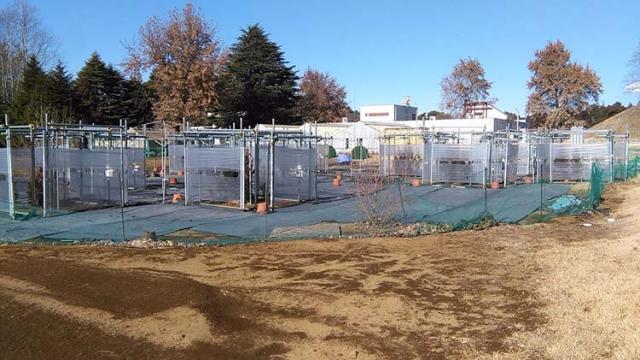Home > Research > Research Results > Research Results 2018 > Relationship between the ozone concentration and the emission rate of the biogenic volatile organic compounds from cedar leaves
Update:September 18, 2018
Main content starts here.
Relationship between the ozone concentration and the emission rate of the biogenic volatile organic compounds from cedar leaves
| Article title |
Differences in monoterpene emission characteristics after ozone exposure between three clones representing major gene pools of Cryptomeria japonica. |
|---|---|
| Author (affiliation) |
Takafumi Miyama (a), Hiroyuki Tobita (b), Kentaro Uchiyama (c), Kenichi Yazaki (b), Saneyoshi Ueno (c), Takami Saito (b), Asako Matsumoto(c), Mitsutoshi Kitao (d), Takeshi Izuta (e) (a) Department of Disaster Prevention, Meteorology and Hydrology, FFPRI, Tsukuba, Ibaraki, Japan. (c) Department of Forest Molecular Genetics and Biotechnology, FFPRI, Tsukuba, Ibaraki, Japan. (d) Hokkaido Research Center, FFPRI, Sapporo, Hokkaido, Japan. (e) Tokyo University of Agriculture and Technology, Fuchu, Tokyo, Japan. |
| Publication Journal |
Journal of Agricultural Meteorology, 74(3):102-108, July 2018, DOI:10.2480/agrmet.D-17-00043( External link ) |
| Content introduction |
Although the number of occurrences of photochemical smog, wherein ozone is a primary component, has decreased, high ozone concentrations are still observed in suburban areas during the summer season. In a relatively clean atmosphere, the biogenic volatile organic compounds emitted from plants play an important role in sustaining the moderate atmospheric oxidation capacity; however, in polluted atmospheres with high levels of ozone, it may cause an acceleration in the increase of ozone concentration. Therefore, trees that emit low levels of biogenic volatile organic compounds have been selected and planted as roadside trees to maintain the safe atmospheric ozone levels. In this study, we assumed that even in planted forests in suburban areas, an approach that selects and plants tree with a low biogenic volatile organic compound emission rate is effective, and we compared the emission rate of biogenic volatile organic compounds under different ozone concentrations for three representative clones of Japanese cedar (Cryptomeria japonica), which are Yakushima, omote-sugi, and ura-sugi cedars. We planted three types of seedlings at our test facility, and, for a period of 15 months, we raised them in an area with an ozone concentration equivalent to the current concentration, i.e., low concentration area, and in an area where the ozone concentration was twice the current concentration, i.e., high concentration area, which is predicted to occur in future. Then, we used analytical equipment to measure the emission rate of biogenic volatile organic compounds emitted from the leaves. In the low concentration area, all three types demonstrated low levels of biogenic volatile organic compound emissions. However, in the high concentration area, emissions from the Yakushima, omote-sugi, and ura-sugi cedars increased to ~15, 2.2, and 1.2 times the low concentration area, respectively. We concluded that as there is a significant difference in the biogenic volatile organic compounds emission rate in high ozone concentration areas when planting trees in suburban areas, it is desirable to perform tests and select seedlings carefully, with due consideration for the potential future high ozone concentration conditions. We expect that these results will benefit forestry management regimes that consider preservation of the atmospheric environment.
|
Copyright © Forest Research and Management Organization. All rights reserved.

